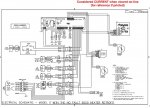I have a 1995 Hot Spring Grandee that has the original Series 1 5.5 KW No-Fault heater in it. I recently replaced the temp sensor and hi-temp limit thermistors and the heater relay. The tub has been running flawlessly for these last few months since I did that work and started it up. Recently, we've had a pretty good cold snap here with overnight temperatures sometimes going down as low as -29C (-20 F) and daytime highs around -25C (-13F). Not exactly artic temperatures but on the cold side for here, especially considering the mild winter we were having until this polar vortex swooped in a couple weeks ago. The tub worked fine through the worst of all that easily maintaining the water temp at 40 C (104 F).
We're still in the cold snap but it has warmed up a bit so overnight temps are now around -17C (0 F) and warming up a few degrees during the day. That should be easier on the heater than the colder temps we just went through, right?
A couple nights ago I got in the tub and it wasn't up to temp. Couldn't feel any heated water coming through the circulation inlet. I got into the engine compartment the next morning and found the 30 Amp GFI breaker had tripped so I reset it and the heater came on line again. The water temp at that point was about 32C (90F). I checked the temp that night and it was about 39-ish C (~102 - 103-ish F). I got in the tub and found there wasn't any hot water coming in through the inlet which means that 30 Amp breaker had tripped again.
Below is the wiring diagram for the tub. It shows the 30 Amp breaker basically just powers the heater. As far as I can tell, there's really only two things that could be causing this problem: the heater or the breaker. I suppose it could be bad/corroded connections on or to the heater as well but let's assume that's not the problem for now.
If it was the heater, why would it all of a sudden be drawing so much more current that it's tripping the breaker when it gets close to the normal operating temperature now when outside temps are 13C/20F warmer than a week ago and the tub worked fine through all of that? How do spa heaters generally fail? They're just a heating element so don't they just generally work or not with no "in-between"?
What about the breaker? I don't know much about them and I'm not sure how old this particular unit is. We got that sub-panel for our first tub in the late 90s and I'm not sure if it was new or used then. Knowing me, it was probably used but I can't be sure of that. If it was new at that time it would have about 15 or 16 years of use on it as I went about 3 or 4 years without a working hot tub so the panel wasn't used. Do circuit breakers get "tired"? Could it be that this old breaker just ain't cuttin' the mustard anymore and is now failing at a lower than rated amperage?
What are people's educated guesses on what the likely cause of the problem is? Has anybody had a similar experience?

We're still in the cold snap but it has warmed up a bit so overnight temps are now around -17C (0 F) and warming up a few degrees during the day. That should be easier on the heater than the colder temps we just went through, right?
A couple nights ago I got in the tub and it wasn't up to temp. Couldn't feel any heated water coming through the circulation inlet. I got into the engine compartment the next morning and found the 30 Amp GFI breaker had tripped so I reset it and the heater came on line again. The water temp at that point was about 32C (90F). I checked the temp that night and it was about 39-ish C (~102 - 103-ish F). I got in the tub and found there wasn't any hot water coming in through the inlet which means that 30 Amp breaker had tripped again.
Below is the wiring diagram for the tub. It shows the 30 Amp breaker basically just powers the heater. As far as I can tell, there's really only two things that could be causing this problem: the heater or the breaker. I suppose it could be bad/corroded connections on or to the heater as well but let's assume that's not the problem for now.
If it was the heater, why would it all of a sudden be drawing so much more current that it's tripping the breaker when it gets close to the normal operating temperature now when outside temps are 13C/20F warmer than a week ago and the tub worked fine through all of that? How do spa heaters generally fail? They're just a heating element so don't they just generally work or not with no "in-between"?
What about the breaker? I don't know much about them and I'm not sure how old this particular unit is. We got that sub-panel for our first tub in the late 90s and I'm not sure if it was new or used then. Knowing me, it was probably used but I can't be sure of that. If it was new at that time it would have about 15 or 16 years of use on it as I went about 3 or 4 years without a working hot tub so the panel wasn't used. Do circuit breakers get "tired"? Could it be that this old breaker just ain't cuttin' the mustard anymore and is now failing at a lower than rated amperage?
What are people's educated guesses on what the likely cause of the problem is? Has anybody had a similar experience?

Last edited:

